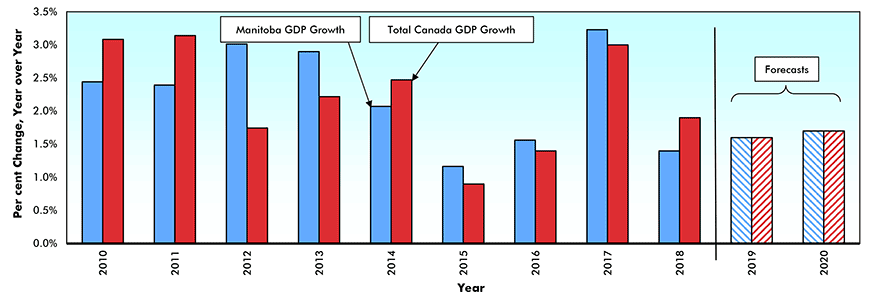Approaching 2020, the outlook for Manitoba is overshadowed by two factors. First, the recent deterioration in Canada-China diplomatic relations and the resultant imposition, by China, of import restrictions on canola is largely responsible for causing the growth of the province’s exports to stall year to date after posting a 14% increase during the first six months of 2018.
So far this year, the impact of this canola induced drop in exports to China has been offset by the gains in foreign sales of pharmaceuticals to the U.S. and of pork to Japan. While trade appears likely to have almost no net impact on Manitoba’s growth this year, the outlook for the province’s exports should improve in 2020 for three reasons. These include: first, the ratification of the Canada, U.S., Mexico Trade Agreement (CUSMA) to replace the North America Free Trade Agreement (NAFTA); second, the gradual expansion of trade with the Pacific Rim countries that signed the Comprehensive and Progressive Trans-Pacific Partnership (CPTPP); and finally, the province’s full integration into the New West Partnership trade pact with Saskatchewan, Alberta and British Columbia that takes effect at the beginning of 2020. Together, these agreements should give a much-needed boost to trade-related investment and employment in the province over the medium term.
Another factor that has weighed on the Manitoba economy this year has been a slowdown in spending on major projects. According to the latest Stats Canada (CAPEX) Survey, after posting a modest 1.9% gain in 2018, capital expenditures in Manitoba are projected to contract by 5% this year. This pullback is due in large part to a 30% drop in spending by utilities following the completion of work on the Manitoba section of Enbridge’s Line 3 oil pipeline and Manitoba Hydro’s Bipole III transmission line.
Looking ahead, the solid year-to-date increases in planned spending on institutional construction projects (+98%) and commercial projects (+29%) suggest non-res construction spending will strengthen in 2020. Also, although it is scheduled to be in service by late 2020, the Keeyask Generation Project should continue to make a positive contribution to construction spending well into 2020.
Other major construction projects expected to underpin spending in 2020 include an upgrade to Winnipeg’s North End Sewage Treatment Plant, a pea processing plant in Brandon Manitoba and an expansion of Simplot’s potato processing facility outside Portage La Prairie.
Consistent with the weakening pattern of exports and the slowdown in non-residential construction, the pace of hiring in Manitoba has slowed since the beginning of the year. Nevertheless, unemployment in the province, currently at 5.8%, appears to be constrained by an increased outflow of Manitobans to other provinces. Looking forward, the sustained uptrend in CFIB’s Business Barometer since April and the fact that the private sector job vacancy rate is at a four-and-a-half-year high suggest that the province’s job market will improve heading in 2020.
Given the relatively sluggish pace of employment growth, it is not surprising that consumer spending did not make a significant contribution to growth through the final months of 2018 and into the first quarter of this year. Based on data for the second quarter, there are signs that spending has picked up heading into the second half. While year-to-date sales of motor vehicles (-6%) and home furnishings (-16.5%) are both well below year-ago levels, this weakness has been more than offset by stronger sales at food, general merchandise and pharmaceutical stores. Also, the recent (July 1st) reduction in the provincial sales tax will give a modest boost to consumers’ purchasing power in the second half.
Faced with an unprecedented inventory of completed and unabsorbed (mostly single-detached, semi-detached and row) dwellings at the beginning of the year, it appears that a significant number of Manitoba’s home builders kept their shovels out of the ground during the first half of the year. Although Manitoba’s apartment vacancy rate at 3% is the highest it has been since 1969, multiple unit starts are up by 44.5% year to date.
Looking ahead, the outlook for residential construction in particular and the Manitoba economy as a whole continues to be limited by the uncertain duration and possible broadening of the import restrictions introduced by the government of China in March of this year. Assuming that the trade issues are resolved in the near term and given the above-noted improvement in business confidence and the stronger outlook for non-res construction, the province’s outlook for 2020 takes on a rosier hue.
John Clinkard has over 35 years’ experience as an economist in international, national and regional research and analysis with leading financial institutions and media outlets in Canada.
Real* Gross Domestic Product (GDP) Growth — Manitoba vs Canada

Chart: ConstructConnect – CanaData.











Recent Comments
comments for this post are closed